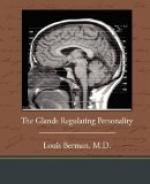his health had quite failed, and that indigestion,
headaches, with a looming hopeless breakdown of body
and mind made his life a burden and a curse. The
twenty years of research he devoted to the problems
of evolution were one long torture. For sixteen
more years, during which he worked upon and produced
immortal classics of biology, he was the most wretched
and unhappy sufferer from neurasthenia. His life
was a continuous alternation of small doses of work
and large doses of rest. So he was enabled to
publish twenty-three volumes of original writing and
fifty-one scientific papers. Living a sort of
quasi-sanitarium life, with the rules and regulations
of one undergoing a rest cure for thirty-six years,
he thus accomplished infinitely more than the millions
who have led the strenuous life. That he thus
survived, as a genius, among the perils of an intellectual
nature in an environment for which his adrenals sentenced
him to destruction, must be put down in large measure
to the ministrations and good sense of wife and children
who supplied him with the endocrine energy he lacked.
All these details I have given in the attempt to analyze
the internal secretion constitution of this great
man of genius, to establish that he really suffered
from inadequate function of his adrenal glands, for
the symptoms of chronic though benign adrenal insufficiency
coincide in their mass effect with the story of his
life. He was not a good animal, as Herbert Spencer
declared was a first sine qua non of the successful
life. He was a poor animal, the poorest of animals,
because he possessed poor adrenals. What saved
him was his congenitally superior pituitary (the nidus
of genius) and the overacting thyroid, which combined
to compensate to some extent for his fundamental lack.
According to his son he rose early because he could
not lie in bed, and he would have liked to get up
earlier than he did.
What other hints have we that in spite of his fatigue
disease he was a pituitocentric? The record of
his physique and physiognomy, documentary and that
left in portraits and photographs. He was tall
and thin and his frame was naturally strong and large.
Face was ruddy, and his grey eyes looked out from
under deep overhanging brows and bushy eyebrows.
The ears were large and prominent, the hair straight,
the nose broad and well developed. All these are
distinctive pituitary traits. The photograph
of him taken by Maull and Fox in 1854 shows his chin
to be the square firm kind that goes with the ante-pituitary
type physique. (This photo is the frontispiece of
the collection of essays entitled “Darwinism
and Modern Science,” edited by A.C. Seward
and published in 1909). Charles Darwin, we may
say, then, lived the life of one with a hyperfunctioning
pituitary, the anterior portion dominating the posterior,
a thyroid excess, and an adrenal much deficient, the
combination settling the fate of a grand intellect
in an invalid. It is interesting to note that
an extant portrait of Erasmus Darwin, Darwin’s
distinguished grandfather, shows a pituitocentric,
but with a rounder head and a fatter face, which point
to a predominance of the post-pituitary over the ante-pituitary.
Correspondingly, he was more speculative and poetic
intellectually than his grandson, and more irascible
and imperious in his moods.




